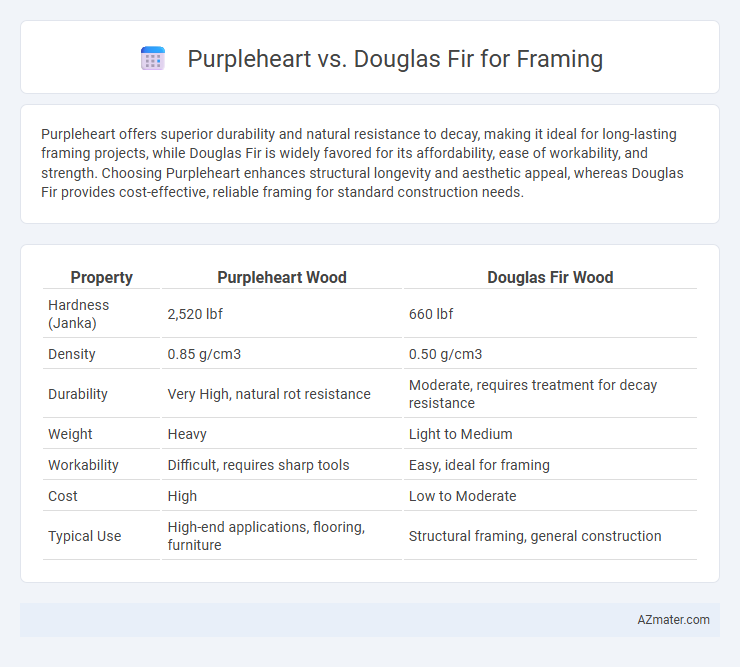Purpleheart offers superior durability and natural resistance to decay, making it ideal for long-lasting framing projects, while Douglas Fir is widely favored for its affordability, ease of workability, and strength. Choosing Purpleheart enhances structural longevity and aesthetic appeal, whereas Douglas Fir provides cost-effective, reliable framing for standard construction needs.
Table of Comparison
| Property | Purpleheart Wood | Douglas Fir Wood |
|---|---|---|
| Hardness (Janka) | 2,520 lbf | 660 lbf |
| Density | 0.85 g/cm3 | 0.50 g/cm3 |
| Durability | Very High, natural rot resistance | Moderate, requires treatment for decay resistance |
| Weight | Heavy | Light to Medium |
| Workability | Difficult, requires sharp tools | Easy, ideal for framing |
| Cost | High | Low to Moderate |
| Typical Use | High-end applications, flooring, furniture | Structural framing, general construction |
Introduction to Purpleheart and Douglas Fir
Purpleheart, known for its vibrant purple hue and exceptional hardness, offers remarkable durability and resistance to decay, making it a premium choice in framing applications requiring strength and aesthetics. Douglas Fir is widely favored for its consistent straight grain, high strength-to-weight ratio, and affordability, establishing it as a reliable, cost-effective option for structural framing. Both woods provide unique benefits, with Purpleheart excelling in longevity and visual appeal, while Douglas Fir balances performance and economic value.
Wood Characteristics and Appearance
Purpleheart offers exceptional hardness and durability with a dense grain, making it highly resistant to wear and insect damage, which suits heavy-duty framing projects. Douglas Fir features a straight grain with moderate hardness, providing flexibility and ease of cutting, ideal for traditional framing where structural strength and stability are essential. Visually, Purpleheart showcases a distinctive deep purple hue that darkens over time, while Douglas Fir presents a warm reddish-brown tone with prominent growth rings, catering to different aesthetic preferences in framing.
Structural Strength and Load-Bearing Capacity
Purpleheart offers superior structural strength and exceptional load-bearing capacity compared to Douglas Fir, making it ideal for heavy-duty framing applications. Douglas Fir is valued for its consistent strength-to-weight ratio and widespread availability but has lower density and hardness than Purpleheart. For projects requiring maximum durability and resistance to stress, Purpleheart's hardness (approximately 2200 Janka) and high modulus of elasticity provide enhanced stability under load.
Durability and Resistance to Decay
Purpleheart exhibits exceptional durability and resistance to decay, making it a prime choice for framing in environments prone to moisture and pest exposure. Its dense, tight grain structure provides superior strength and natural resistance to rot compared to Douglas Fir, which, while widely used, is more susceptible to fungal attacks and requires additional treatment for longevity. For long-term structural integrity in harsh conditions, Purpleheart's natural resilience significantly outperforms Douglas Fir in framing applications.
Workability and Ease of Use
Purpleheart's dense and hard texture makes it challenging to cut and shape but results in a durable frame, while Douglas Fir offers superior workability with its softer grain, allowing for easier sawing, nailing, and fastening. Douglas Fir's natural straight grain and moderate hardness reduce wear on tools and minimize splitting during installation, making it a preferred choice for framing projects requiring speed and efficiency. Purpleheart's high density demands sharp tools and slower processing but provides excellent structural strength and resistance to deformation over time.
Cost Comparison and Availability
Purpleheart, a dense and vibrant hardwood, typically costs significantly more than Douglas Fir due to its exotic origin and limited supply. Douglas Fir is widely available in North America and offers a cost-effective option for framing, with prices generally lower and more stable. The rarity and import requirements of Purpleheart increase its price and reduce availability compared to the abundant and locally sourced Douglas Fir.
Environmental Impact and Sustainability
Purpleheart wood, sourced from tropical rainforests primarily in Central and South America, raises sustainability concerns due to habitat disruption and slower growth rates compared to Douglas Fir. Douglas Fir, native to North America, is widely available from sustainably managed forests certified by organizations like FSC, making it a more eco-friendly choice for framing. Its rapidly renewable status and lower carbon footprint contribute to environmentally responsible construction practices compared to the denser, less renewable Purpleheart.
Applications in Framing Projects
Purpleheart offers exceptional hardness and durability, making it ideal for heavy-duty framing projects requiring long-lasting structural integrity. Douglas Fir is widely preferred for its strength-to-weight ratio and ease of handling, commonly used in residential and commercial framing where cost-effectiveness and availability are crucial. Both woods excel in framing applications, but Purpleheart's resistance to decay suits outdoor and high-stress environments, while Douglas Fir remains a versatile choice for standard construction.
Maintenance and Longevity
Purpleheart wood offers exceptional durability and natural resistance to decay and insect damage, significantly reducing maintenance needs for framing projects. Douglas Fir, while commonly used in framing due to its strength and availability, requires regular treatments and inspections to prevent rot, insect infestations, and moisture-related damage. The higher density and stability of Purpleheart contribute to a longer lifespan and lower upkeep costs compared to Douglas Fir in structural applications.
Conclusion: Which Wood is Best for Framing?
Purpleheart offers exceptional strength and durability, making it highly resistant to warping and decay, which is ideal for long-lasting framing projects. Douglas Fir, known for its excellent dimensional stability and affordability, remains a popular choice for its ease of handling and consistent performance in structural framing. For cost-effective framing with reliable strength, Douglas Fir is best; for superior hardness and weather resistance in premium builds, Purpleheart is the optimal wood choice.

Infographic: Purpleheart vs Douglas Fir for Framing
 azmater.com
azmater.com